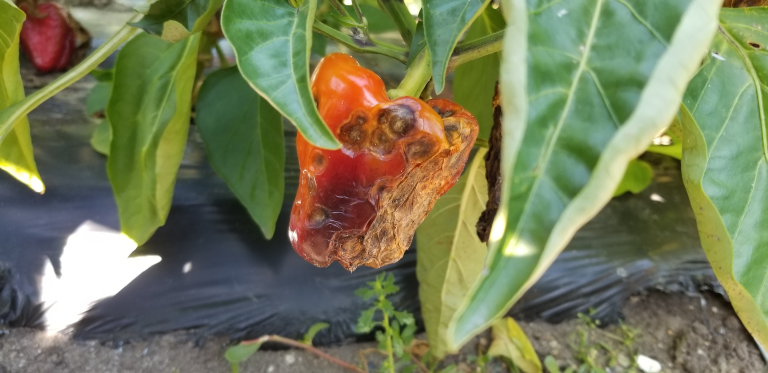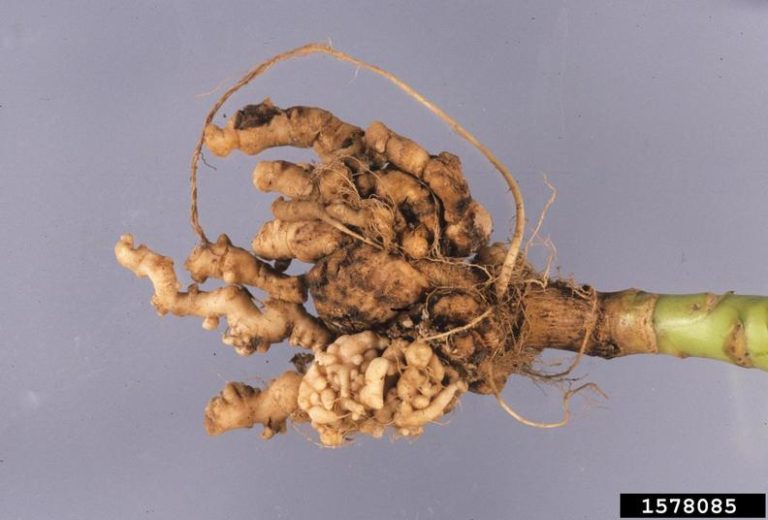Introduction
Root-knot of vegetables, primarily caused by Meloidogyne species, are among the most destructive plant pathogens affecting a wide range of crops worldwide. In Nepal, these nematodes pose a significant threat to vegetable and spice crops, directly impacting agricultural productivity and the livelihoods of farmers. Root-knot nematodes not only lead to extensive root damage but also predispose crops to secondary infections, creating an environment that hinders overall crop health. These pathogens cause substantial yield losses in economically important crops such as tomatoes, cucumbers, carrots, garlic, and turmeric, which are staples in Nepali agriculture.
This blog post explores the life cycle of root-knot nematodes, their impact on crops, and integrated management practices that are particularly effective in Nepal.
Taxonomy and Morphology of Meloidogyne spp.
The root-knot nematode belongs to the family Meloidogynidae, with the genus Meloidogyne encompassing over 100 species, though only a few are highly pathogenic to vegetables and spices in Nepal. Key species include Meloidogyne incognita, Meloidogyne javanica, and Meloidogyne hapla. These nematodes are microscopic, slender, and unsegmented, with a stylet and esophageal glands adapted for parasitic feeding.
The infective juvenile stage, known as J2, is particularly significant because it is the life stage that penetrates plant roots, initiating the disease cycle. Once inside the roots, these nematodes induce gall formation, which disrupts water and nutrient transport in the plant, ultimately reducing crop yield and quality.
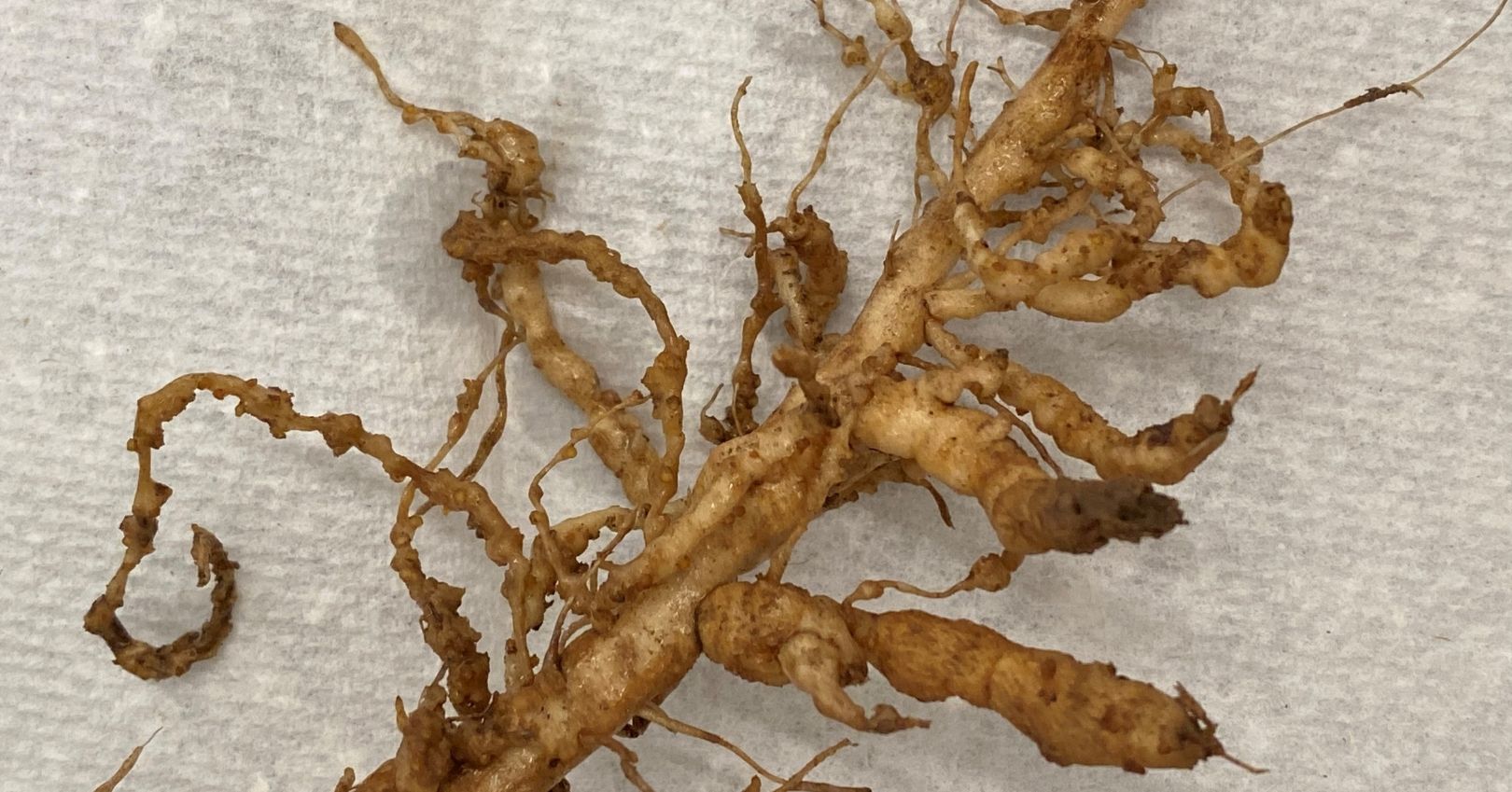
Source: Utah Vegetable Production Guide
The following is a tabular representation of the known Meloidogyne species reported in Nepal and their associated host agricultural plants. This data is based on agrarian nematology studies and reports specific to Nepal:
| Meloidogyne Species | Common Name | Primary Host Plants in Nepal |
|---|---|---|
| Meloidogyne incognita | Southern Root Knot | Tomato, potato, eggplant, chili, cucumber, beans, okra, tobacco |
| Meloidogyne javanica | Javanese Root Knot | Tomato, potato, pumpkin, squash, gourds, legumes, banana |
| Meloidogyne hapla | Northern Root Knot | Carrot, lettuce, strawberry, potato, tea |
| Meloidogyne graminicola | Rice Root Knot | Rice, wheat, maize, millet |
| Meloidogyne exigua | Coffee Root Knot | Coffee (in mid-hill regions), tea |
| Meloidogyne arenaria | Peanut Root Knot | Peanut, vegetables (okra, beans) |
| Meloidogyne chitwoodi | Columbia Root Knot | Potato (reported in higher elevations) |
Key Insights:
- Prevalence:
- M. incognita and M. javanica are the most prevalent species in Nepal, affecting a wide range of vegetables and cash crops in the Terai and mid-hill regions.
- M. graminicola is a significant pest in rice paddies, especially in irrigated lowland.
- Regional Variation:
- Mid-hills: M. hapla and M. exigua are notable in temperate and subtropical crops like coffee, tea, and vegetables.
- Terai: M. incognita and M. javanica dominate due to the warmer climate and diverse cropping systems.
Disease Cycle of Root-Knot Nematodes
Understanding the disease cycle of root-knot nematodes is essential for developing effective management strategies. The lifecycle of Meloidogyne spp. begins with the deposition of eggs in gelatinous masses within or near plant roots. Under favorable conditions, J2 juveniles emerge from the eggs and migrate through the soil for host plants. When J2 nematodes locate a suitable host, they penetrate the root tissue, often near the root tip, and establish a feeding site within the plant’s vascular tissue. This penetration process initiates the formation of root galls, which are swollen areas caused by the nematodes’ manipulation of plant cell division.
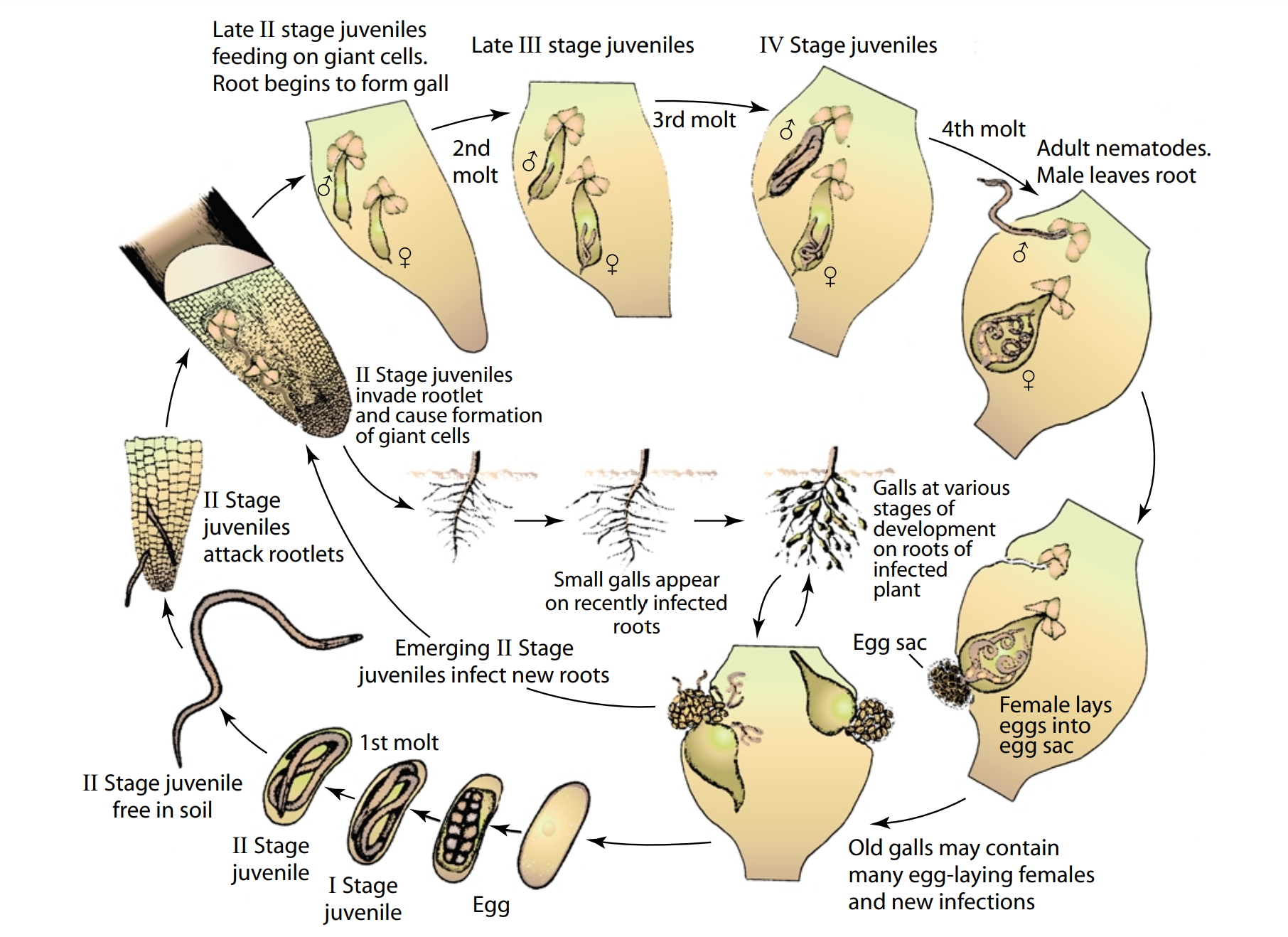
Source: Plant Pathology by George N. Agrios
The J2 stage is crucial, as it differentiates into a sedentary female that remains embedded within the root tissue, continuing to feed and lay eggs, thus perpetuating the nematode population in the soil.
The detailed lifecycle of the root-knot nematode is described in its different stages of the lifecycle as:
1. Egg Stage
- Description: The lifecycle begins with the female nematode laying eggs. Each female can produce hundreds to thousands of eggs in a single cycle. These eggs are typically deposited in a gelatinous matrix, often within or on the surface of infected plant roots.
- Location and Protection: The gelatinous egg mass protects eggs from environmental stressors and predators, giving them a greater chance of survival. This matrix can adhere to soil particles or root surfaces, allowing eggs to remain viable for several months under favorable conditions.
- Incubation: Development within the egg depends heavily on environmental conditions, particularly soil temperature and moisture. Warmer, moist conditions accelerate egg hatching, making certain seasons more favorable for nematode proliferation.
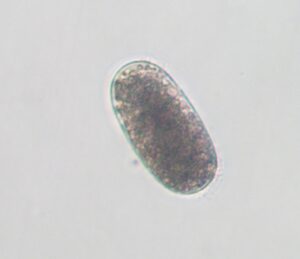
Source: NC State University
2. Juvenile Stage 1 (J1)
- Embryonic Development: The first juvenile stage, J1, occurs entirely within the egg. This stage is characterized by significant growth and development as the nematode begins to prepare for its life as a plant parasite.
- Non-infective Stage: J1 juveniles do not exit the egg, and they remain within the egg as they develop into the second juvenile stage, which is the infective stage.

Source: Clemen Oliveira
3. Infective Juvenile Stage 2 (J2)
- Emergence: After the J1 stage molts within the egg, it becomes a J2 juvenile, which is the first free-living and infective stage. J2 juveniles are slender and have specialized stylets, needle-like structures used for piercing plant tissue.
- Migration and Host Detection: J2 juveniles actively move through soil in search of plant roots. They use chemical cues to locate suitable host plants. Root exudates from healthy plants often attract J2 juveniles, drawing them toward areas of new root growth where the cell walls are less lignified and easier to penetrate.
- Root Penetration: Once a J2 nematode reaches a suitable root, it penetrates the epidermis near the root tip, usually around elongation zones where cells are actively dividing and easier to access. This entry point initiates infection. The J2 nematode uses its stylet to break through cell walls and enter the root cortex.

Source: Clemen Oliveira
4. Establishment of Feeding Site
- Migration Within Root Tissue: After penetrating the root, the J2 juvenile migrates intracellularly through the root cortex, reaching the vascular cylinder (stele), particularly near the root’s vascular tissue. This migration disrupts root cell integrity and damages cell structure.
- Formation of Giant Cells: Once in the vascular region, the nematode injects secretions through its stylet into root cells. These secretions manipulate the host plant’s cellular mechanisms, causing certain root cells to enlarge and develop into specialized “giant cells.” Giant cells are highly metabolically active and serve as a nutrient-rich feeding site for the nematode.
- Gall Formation: The formation of giant cells leads to swelling or galling around the infection site, commonly referred to as “knots.” These galls disrupt the plant’s vascular system, impeding the flow of water and nutrients, which contributes to overall plant stress and symptoms such as stunted growth, yellowing, and wilting.
5. Development into Third and Fourth Juvenile Stages (J3 and J4)
- Molting: Within the root tissue, the J2 juvenile molts twice, developing into the third (J3) and then fourth (J4) juvenile stages. These stages are still within the root, where the nematode remains sedentary.
- Growth and Sexual Differentiation: During these juvenile stages, the nematode’s body undergoes significant enlargement, and it starts to differentiate into male or female forms. However, most root-knot nematodes develop as females, especially in highly favorable environments with abundant resources in the giant cells.
- Male Emergence: If environmental conditions deteriorate (e.g., nutrient limitations in the plant), some J4 juveniles may differentiate into males, which are free-living and non-parasitic. These males exit the root to seek new environments, though their role in reproduction is generally limited since root-knot nematodes primarily reproduce parthenogenetically (without fertilization by a male).
6. Adult Female and Egg Production
- Mature Female: The female nematode becomes fully sedentary within the root tissue, remaining anchored at her feeding site (giant cells). She continues to feed on plant nutrients, which sustain her reproductive processes.
- Egg Production: After reaching maturity, the female begins laying eggs. She produces a protective gelatinous matrix around her eggs to shield them from adverse environmental conditions and certain biological antagonists.
- Egg Deposition: Females can lay hundreds to thousands of eggs within the root tissue or on the root surface, completing the lifecycle. These eggs can survive in the soil for extended periods, waiting for favorable conditions to hatch.
7. Dispersal and Population Spread
- Soil-Borne Spread: The eggs and J2 juveniles spread naturally through the soil, where they can survive under suboptimal conditions, effectively waiting for suitable hosts and environmental conditions to continue the cycle.
- External Vectors: Nematode-infested soil, plant material, and water can carry eggs or infective J2 juveniles, facilitating nematode spread. Human activity, such as the movement of infected plants or soil, can significantly contribute to the dispersal of nematodes within fields and between agricultural regions.
8. Favorable Environmental Conditions for Nematode Life Cycle
- Temperature and Moisture: The life cycle of Meloidogyne spp. is heavily influenced by temperature and soil moisture. Optimal conditions typically range from 20°C to 30°C, which can lead to rapid development and increased generations per season.
- Seasonal Influence: In tropical and subtropical climates like those in Nepal, root-knot nematodes can complete multiple life cycles in a single growing season. Warmer months generally coincide with higher nematode activity and infestation levels, contributing to seasonality in disease severity.
Symptoms and Identification
Root-knot nematodes cause distinct symptoms that can be observed both above and below ground. Root-knot nematodes damage plants by devitalizing root tips and causing the formation of swellings of the roots which are characterized by gall formation or “knots,” which vary in size and are often visible to the naked eye. These galls disrupt the plant’s vascular system, reducing the efficient transport of water and nutrients, resulting in stunted plant growth.
Above ground, infected plants exhibit symptoms such as yellowing, wilting, reduced vigor, and, in severe cases, plant death. These symptoms can be mistaken for nutrient deficiencies or drought stress, which makes laboratory diagnostic methods essential.
Nematode infestations are typically diagnosed through microscopic examination of root tissues or soil samples. Advanced diagnostic techniques, such as polymerase chain reaction (PCR), can be used to identify Meloidogyne spp. accurately, though they are less accessible to smallholder farmers in Nepal.
Impact on Agriculture in Nepal
The economic impact of root-knot nematodes in Nepal is significant, as infestations directly reduce crop yields and increase production costs. Farmers in nematode-affected areas often report lower yields, reduced crop quality, and increased expenses due to the need for additional pest control measures.
Vegetables and spices are staple crops in Nepal, not only for domestic consumption but also for local trade. Root-knot nematodes can severely impact the productivity of these crops, reducing the overall profitability of farming operations, especially among smallholders. This impact on crop health also affects soil health, as heavily infested soils may take years to recover their productivity levels. The persistent presence of nematodes in soil poses a challenge to sustainable agricultural practices, requiring farmers to invest in long-term soil health management to reduce nematode pressure.
Environmental Conditions Favoring Nematode Proliferation
Root-knot nematodes thrive in specific environmental conditions that are prevalent in various parts of Nepal. They prefer warm, moist soils with a pH range of 5.5 to 6.5, conditions that are common in the Terai and mid-hill regions of Nepal where many vegetables and spices are cultivated. High temperatures and adequate moisture levels accelerate the nematode’s lifecycle, allowing multiple generations to develop within a single growing season. Seasonal variations also play a role in nematode proliferation, with higher infestations often occurring during the warmer months. Understanding these environmental conditions can help farmers implement timely management strategies, particularly before the nematode population reaches damaging levels.
Management Practices for Root-Knot Nematode
Managing root-knot nematodes requires an integrated approach combining cultural, biological, and, where necessary, chemical methods. In Nepal, where resource availability can vary widely among farmers, implementing a cost-effective and sustainable nematode management strategy is crucial.
1. Cultural Practices
Cultural practices form the foundation of nematode management. Crop rotation is one of the most effective cultural methods, as it prevents nematode populations from building up in the soil. Rotating vegetables and spices with non-host crops, such as legumes or cereals, interrupts the nematode lifecycle. In Nepal, recommended rotation cycles for nematode-prone areas are typically 2-3 years to allow sufficient time for nematode populations to decline naturally.
Organic amendments, such as compost and farmyard manure, can also reduce nematode populations by improving soil health and stimulating beneficial soil microorganisms.
Additionally, soil solarization—covering soil with transparent plastic during hot summer months—has been shown to reduce nematode populations in warmer regions of Nepal, especially in the Terai.
2. Biological Control
Biological control is an environmentally friendly approach that involves the use of natural enemies of nematodes. Beneficial nematophagous fungi, such as Paecilomyces lilacinus and Trichoderma spp., have been shown to effectively suppress Meloidogyne spp. populations by parasitizing nematode eggs and juveniles.
Other biocontrol agents, such as the bacteria Pasteuria penetrans, target nematode stages directly, reducing their capacity to infect plants. In Nepal, there is growing interest in developing bio-based nematode control solutions, with several agricultural research institutions experimenting with locally sourced biological agents.
Additionally, the application of neem-based products has shown promise in reducing nematode infestations due to neem’s natural pesticidal properties.
3. Resistant Varieties
Using nematode-resistant crop varieties offers a practical solution to reducing nematode-induced crop damage. Breeding programs have developed resistant varieties for several crops, including tomatoes and peppers, which can be grown in nematode-infested soils without significant yield loss.
In Nepal, adopting resistant varieties is gradually gaining popularity among farmers in nematode-prone regions, particularly as part of integrated pest management (IPM) programs supported by agricultural extension services. The development of locally adapted nematode-resistant varieties could offer significant benefits, particularly in areas where Meloidogyne spp. pressure is high.
Some research conducted in Nepal showed that planting a grafted tomato plant with the rootstock of wild brinjal (Solanum sisymbriifolium) had shown resistance toward root-knot nematode infestation. (Read Article)
4. Chemical Control
Chemical control, while effective, is generally considered a last-resort option due to environmental concerns and the potential for nematode resistance.
In Nepal, chemical control is often limited to high-value crops where the cost of nematicide application can be justified. Regulatory restrictions on certain nematicides also play a role, as many chemicals used in nematode management in other countries are either unavailable or heavily regulated in Nepal. Up to this date, only 2 chemical nematicides (Fluopyram and Fosthizate) with different trade names are registered in Nepal.

Source: List of Registered Pesticides and Pesticide Consumption Data by PQPMC Nepal
5. Integrated Nematode Management (INM)
For sustainable nematode control, Integrated Nematode Management (INM) combines multiple strategies to keep nematode populations below damaging levels while minimizing environmental impact. INM encourages the use of crop rotation, resistant varieties, and biological control as primary methods, with chemical control as a supplementary tool when necessary. Farmer training is essential for successful INM implementation, as proper timing and application techniques can greatly enhance the effectiveness of management practices. In Nepal, agricultural extension services have a critical role in promoting INM practices, particularly among smallholder farmers who rely on diverse crop rotations and organic methods for nematode control.
Conclusion
Root-knot nematodes pose a formidable challenge to sustainable agriculture in Nepal, affecting a wide range of vegetable and spice crops essential to food security and rural livelihoods. However, through an integrated approach that combines cultural practices, biological control, resistant varieties, and judicious use of chemicals, farmers can manage nematode populations effectively. The success of these strategies depends on understanding the nematode life cycle, environmental factors, and the role of sustainable agricultural practices. As Nepal continues to advance its agricultural sector, investment in nematode-resistant varieties, biological control research, and farmer education will be key to achieving sustainable management of root-knot nematodes and ensuring the resilience of the country’s agricultural systems.


